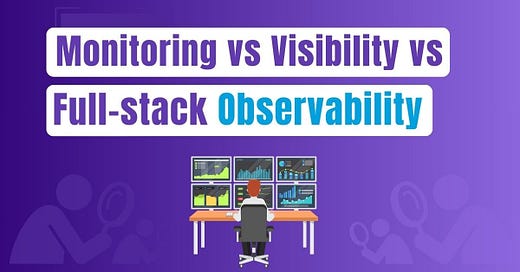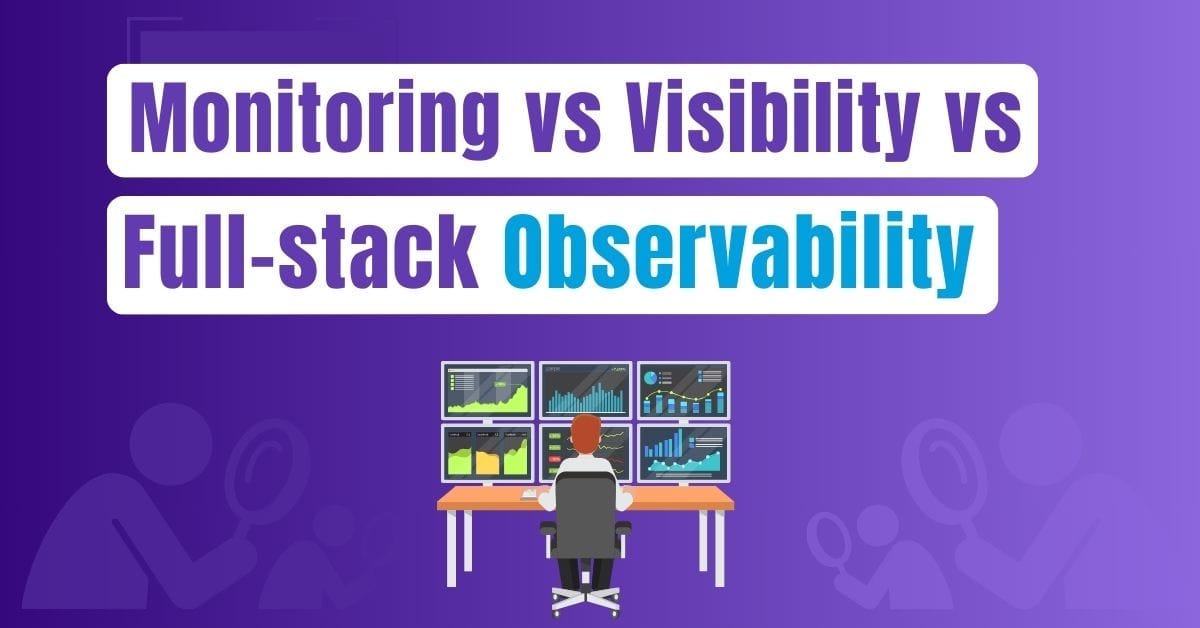Monitoring vs Visibility vs Full-stack Observability: Understanding Codegiant's Comprehensive Approach
In software development, it's important to effectively manage and understand system performance. Three key concepts in this context are monitoring, visibility, and Full-stack Observability.
Monitoring is the continuous process of collecting and analyzing data to ensure that applications and infrastructure are functioning correctly. Visibility goes deeper, providing insights into the root causes and interactions within the system, beyond surface-level metrics.
Full-stack Observability, on the other hand, represents a comprehensive approach, integrating monitoring and visibility across the entire technology stack. This approach facilitates a deeper understanding and proactive management of systems.
Codegiant stands out for its application of Full-stack Observability. Combining monitoring and visibility with advanced data analysis, we offer a comprehensive view of your system's health and performance.
In this article, we'll explore the differences between monitoring, visibility, and Full-stack Observability, and how Codegiant's approach can help you build better software.
Monitoring
As we've mentioned, monitoring is the process of continuously observing a system's operation to ensure it functions as expected. It primarily focuses on aspects like system performance, resource usage (CPU, memory, disk space), network traffic, and error rates. The data collected through monitoring is used for alerting and performance evaluation, helping teams respond to issues promptly.
Limitations of Monitoring Alone
Lack of Contextual Information: Traditional monitoring often focuses on technical metrics without providing the broader context. For instance, it might alert you to a spike in CPU usage but not explain why this spike occurred. Without context, diagnosing and resolving issues becomes more challenging.
Reactive Nature: Monitoring systems are typically reactive. They alert you when something has already gone wrong, rather than providing proactive insights that could prevent issues from happening in the first place.
Limited Visibility in Complex Systems: As systems grow in complexity, traditional monitoring tools may not provide sufficient visibility into all aspects of the system. They might be good at tracking individual components but fall short in understanding the interactions and dependencies between different parts of the system.
Inability to Handle Distributed Environments: Traditional monitoring tools are often not equipped to effectively monitor distributed environments like cloud infrastructure or microservices, where components are constantly changing.
Silos of Information: Monitoring tools can create silos of information, particularly when different tools are used for different aspects of the system. This lack of integration can lead to gaps in understanding and inefficiencies in responding to issues.
While monitoring is essential for maintaining the health and performance of systems, its limitations become apparent, especially in complex, dynamic environments. These limitations have led to the development of more comprehensive approaches like observability and visibility, which aim to provide deeper insights into system behavior and performance.
Visibility
Visibility extends beyond traditional monitoring by providing deeper insights into the workings of an application and its infrastructure. While monitoring focuses on the operational aspects of a system, visibility encompasses understanding the "why" behind the system's behavior.
How Visibility Extends Beyond Monitoring
Visibility takes the concept of monitoring a step further by providing insights into the underlying causes of issues. It goes beyond surface-level metrics to understand the interactions between different components and processes within the system.
This comprehension is key to not just fixing problems but also preventing future occurrences, enabling a shift from reactive to proactive problem-solving.
With an understanding of monitoring and visibility, we can now explore Full-stack Observability.
Full-stack Observability
Full-stack Observability is a comprehensive approach to monitoring and visibility. It involves collecting and analyzing data across the entire technology stack, from the application layer to the infrastructure layer. This approach provides a holistic view of the system, enabling teams to understand how different components interact and affect each other.
Key Components of Full-stack Observability
Integration Across the Entire Tech Stack: Full-stack Observability requires seamless integration of monitoring tools and practices across all layers of the technology stack. This integration allows for a unified view of the system, highlighting how changes or issues in one layer affect others.
Comprehensive Data Analysis and Actionable Insights: Full-stack Observability involves deep analysis of data gathered from every part of the system. This analysis helps generate actionable insights, guiding teams on where to focus their efforts for optimization and improvement.
Traceability and Interdependency Understanding: A key aspect of Full-stack Observability is the ability to trace transactions and workflows across the entire stack, understanding how different components and processes interact. This traceability is crucial for identifying dependencies and potential bottlenecks.
How Codegiant Helps You Achieve Full-stack Observability
Codegiant's approach to Full-stack Observability is based on integrating various elements into a unified platform. Here's a detailed look at how we achieve this:
Unified Platform
Codegiant provides a unified platform for monitoring and visibility across the entire technology stack. This integration is essential for several reasons:
Centralized Data Management: By consolidating various functionalities like issue tracking, CI/CD, and observability into a single platform, Codegiant ensures that all data related to software development and deployment is centralized. This centralization facilitates easier access and analysis of data, leading to more efficient problem-solving and decision-making.
Streamlined Workflows: A unified platform reduces the need for context switching between different tools, thereby streamlining workflows. Developers can track issues, commit code, and monitor their applications' performance all in one place, significantly improving productivity and reducing the time to detect and resolve issues.
Consistent User Experience: Having a single platform for various tasks means a consistent user interface and user experience. This consistency can reduce the learning curve for new team members and improve overall efficiency.
Integration with Grafana and ClickHouse
These integrations are crucial for full-stack observability in several ways:
Advanced Data Visualization (Grafana): Grafana allows for the creation of dynamic, interactive dashboards that visualize complex datasets. This visualization capability makes it easier to monitor system performance, understand trends, and detect anomalies. In Codegiant, Grafana can be used to visualize metrics from various stages of the software development lifecycle, from code commits to deployment.
Efficient Data Processing and Storage (ClickHouse): ClickHouse enhances Codegiant’s data analytics and storage capabilities, particularly for large-scale and high-velocity data. Its column-oriented DBMS architecture enables faster query processing and efficient storage, which is crucial for real-time data analysis and observability. This efficiency supports more responsive monitoring and quicker insights into system performance.
Holistic View of the Software Lifecycle
Codegiant's full-stack observability extends beyond traditional application performance monitoring to include insights into various aspects of the software development process. This holistic approach is beneficial for several reasons:
Comprehensive Monitoring: By covering all aspects of the software development lifecycle, Codegiant provides a more comprehensive view of both the application's health and the overall efficiency of the development process. This includes tracking issues, monitoring CI/CD pipelines, and observing application performance in production.
Proactive Problem Solving: With a complete view, teams can proactively identify and address issues before they escalate. This ability to foresee potential problems based on trends and anomalies across the entire stack is a key advantage of full-stack observability.
Better Collaboration and Communication: Having visibility into all aspects of the development process fosters better collaboration between team members. Developers, QA, and operations teams can work together more effectively when they have access to the same data and insights.
Customizable and Scalable Solutions
Codegiant allows customization of observability tools to meet specific project or organizational needs. This flexibility is crucial for several reasons:
Adaptability to Different Project Requirements: Different projects may have unique monitoring and analysis needs. Customizable dashboards and analytics tools allow teams to tailor their observability solutions to specific requirements, ensuring that the most relevant metrics and data are monitored and analyzed.
Scalability for Growth: As organizations grow and their technology stacks become more complex, their observability needs will also evolve. Codegiant’s scalable solutions can accommodate increasing data volumes and more complex monitoring requirements, ensuring sustained efficiency and performance.
Personalized User Experience: Teams can create a user experience that resonates with their workflow and preferences. This personalization can lead to higher engagement and more effective use of the observability tools.
Conclusion
Codegiant's approach to full-stack observability combines a unified platform and powerful integrations with tools like Grafana and ClickHouse to provide centralized log management, real-time monitoring, and customizable solutions.
By having observability integrated into the same platform where development and deployment occur, teams can easily transition between coding, testing, and monitoring phases.
To start using Codegiant's observability tools, sign up for free via this link.
If you liked this article, or have any questions, feel free to leave a comment below. We'd love to hear from you!




